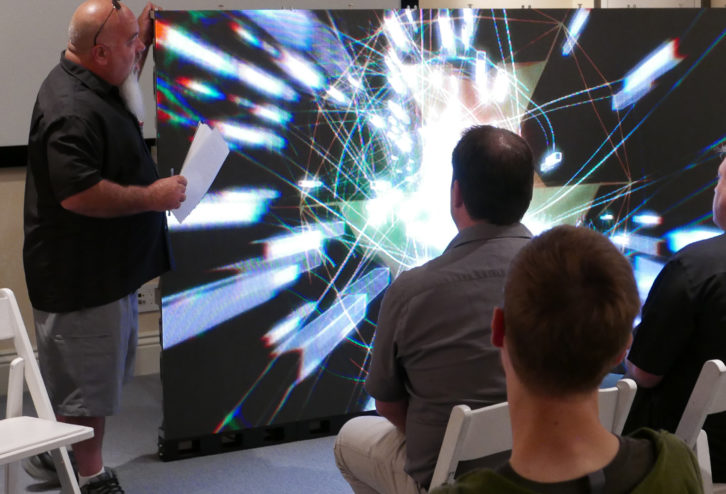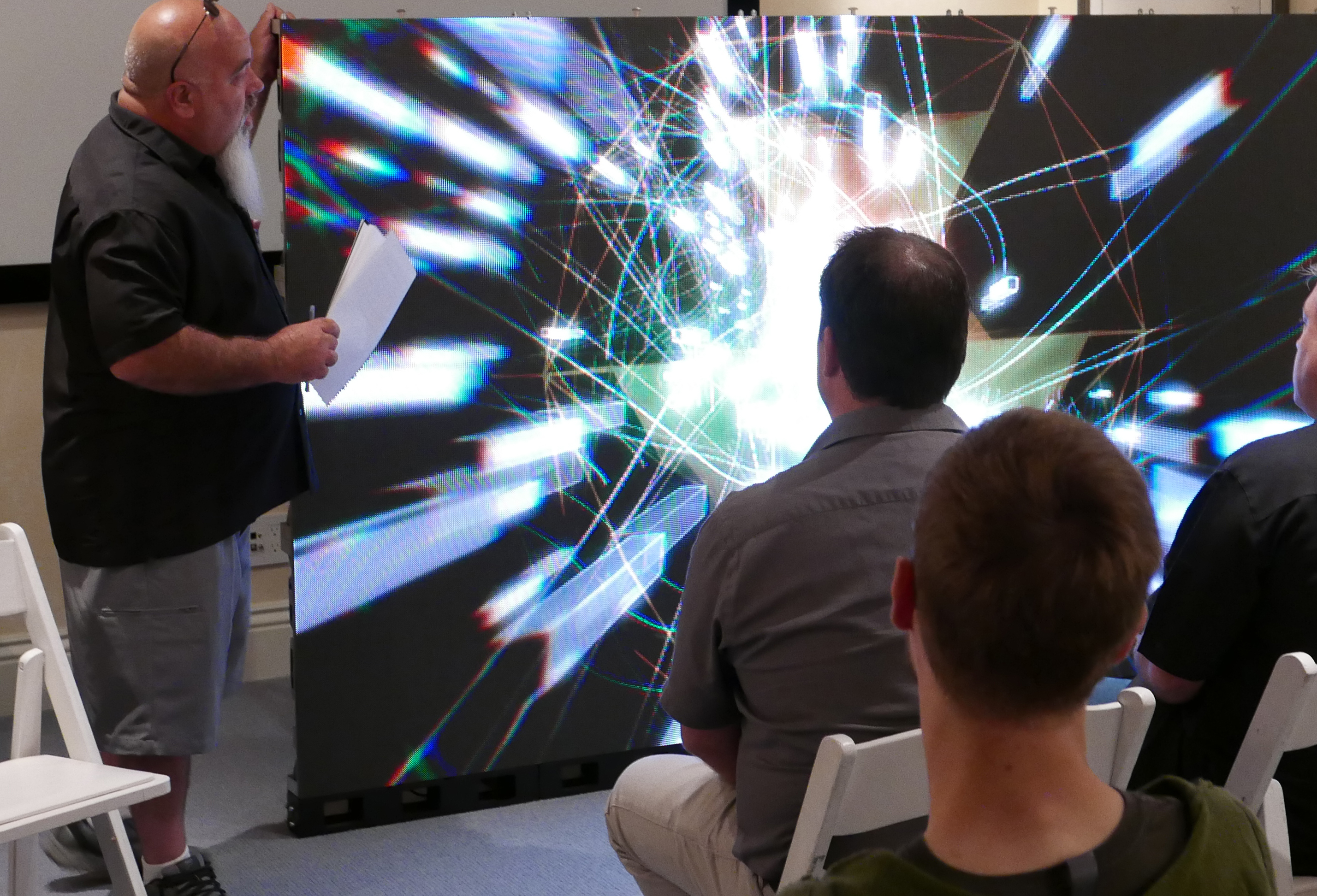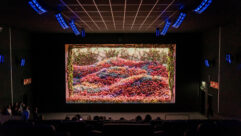

While the high lumen video projector still reigns as a top tool for IMAG and display for staged events, the direct view LED wall has been on the scene for years– and the recent product evolution of LED is now bringing new solutions to the market. The video landscape is changing, and much of the change is in the LED camp, as new technology comes to market that is applicable not just for traditional “stage” settings (think big IMAG), but for the increasing use of screens in new places and new ways: temporary broadcast sets for events of all kinds, trade show booths, lobby or other off-stage areas of events, breakout rooms, movie premiers, and more. The era when the LED market was defined by the big auto shows sucking up all the LED in the country at once, and then those LED walls going back out into the market for IMAG at concerts and festivals mainly is now replaced by a steady stream of LED for diverse applications and events.
For higher resolution applications not involving video projection, it’s historically been a battle of LCD vs. LED. And for most applications without the budget of a major rock tour, that meant tiling many smaller LCDs together to create a single larger image. But the Achilles heel of LCD flat panels in this case was always the bezel that surrounds the screen surface. The bezel contains and protects the electronic circuits that connect the LCD panel to the electronics inside the display. Over the last few years, we have seen the bezel wars, as manufacturers compete for the thinnest bezel. As this is written, top end videowall panels can offer 1.7mm bezel to bezel. The holy grail of a videowall is to eliminate the bezels, making the image seamless. Bezels detract and distract from the image, so the thinner the bezel, the better. The industry has long awaited a zero bezel LCD videowall display but for technical reasons this has not been feasible.

Enter, stage right–so to speak–new generation, finer pixel pitch direct view LED. Let’s look at a little history and then the recent developments that are earning so much positive press today.
At the core is the tiny little LED (light emitting diode) itself. It is a self-contained electric component that emits light when connected to direct current. Through a property called electroluminescence, the LED turns electricity into light, from infrared, to the visible spectrum, and even into ultraviolet. What characterizes LEDs are their small size, low energy consumption, longer lifetime and faster switching than incandescent and fluorescent lamps–and because of that, they have a wide variety of applications.
The scientific concept dates all the way back to 1907 and British experimenter Henry Joseph Round. He discovered the concept of electroluminescence showing that when a potential of 10 volts is applied to a silicon carbide crystal, it would emit yellowish light. Of course, there were subsequent years of experimentation along the way but in 1962, Nick Holonyak Jr. at General Electric developed the first red light-emitting diode in the visible part of the electromagnetic spectrum. Thomas P. Pearsall developed the high brightness LED in 1976. In 1994, Shuji Nakamura of Nichia Corporation made the first high brightness blue LED. The attainment of high efficiency in blue LEDs was quickly followed by the development of the first white LED. Now that white was developed, by changing some of the phosphors inside the LED, green was possible. By combining red, green, and blue LED light (additive mixing) we can make nearly any color of the visible spectrum. Light emitting diodes can now be made in many colors. At first, LEDs were very expensive, some at $200 per diode. By the 1990s, the cost had plummeted to a few cents per LED depending on the specifications. LED developments continued from here at a rapid pace. Moore’s law predicts that the number of transistors in an integrated circuit will double approximately every two years, and it is said that every 36 months we will see that level of development in direct view LED technology.

With direct view LED, either outdoor or indoor, there is a key issue to consider that is not part of other display technologies– pixel pitch. Pixel pitch is the measure of distance between the individual LEDs making up the pixels of the display. There is a direct correlation between price and pixel pitch. A display with 18MM pixel pitch is going to be less expensive than one at 10MM or less. The finer the pixel pitch, the higher the cost. For example, in a coarse pixel pitch display (i.e. 16MM to 24MM) there are fewer LEDs, less material, and less manufacturing labor required. The point to understand, is that the human eye will not be able to see individual pixels if the viewing distance is sufficient. The 18MM wall may look very pixelated close-up but at the proper viewing distance you will not see individual pixels. One conservative formula (there are several others, by the way) to calculate optimal viewing distance is to take the pixel pitch and multiply that by 8. For example, a 4MM pixel pitch is optimally viewed at 32 feet and a 10MM at 80 feet. The reverse calculation says that if you are 200 feet away for normal viewing then take 200 divided by 8 to give you a 25MM pixel pitch wall. Either way, the goal is to calculate optimal viewing and there is generally no need to spend more money than necessary in pixel pitch.
For years, direct view LED displays were relegated primarily to outdoor displays and some small indoor tracer signs. The main selling points were nearly unlimited sizes, brightness as high as 7,000 nits (to compete with high ambient light and even direct sunlight), and outdoor rating. In terms of pixel pitch, the typical ranges were from 10MM to 24MM. While larger pixel pitch LED is certainly thriving, the industry breakthrough has been around fine pitch and ultra-fine pitch displays.
Today, the hot sector of direct view LED displays ranges from 10MM on the top end, down to less than 1MM on the ultra-fine side. Once again, it boils down to the optimum viewing distance in an application. Referring to our math of viewing distances above, we can see that if the typical viewing distance of a display is 32 feet, then a 4MM pixel pitch would be called for. Where it gets complicated is in applications where there will be some people closer and some farther away than the optimal viewing distances, begging the question of what to do. A lot of times it boils down to price. We know that as the pixel pitch lowers, the prices go up. Using our example above, if few people will view the display closer than 32 feet, does it pay to go to a 2.5MM wall?

The sweet spot in indoor or outdoor close-viewing range direct view LED is between 1.5MM and 4MM. If you are hanging a display from the rafters of a convention center (for a big trade show booth for example) then an 8 to 10MM will be fine (in most cases). Those applications aside, it will be the close viewing afforded by the 1.5MM to 4MM products that are most likely to ultimately take the place of the traditional LCD videowall. As a side note, many will have seen the marketing focus on 1MM and sub 1MM panels. No doubt they are fabulous and show how technologically advanced a company might be– but due to pricing and manufacturing concerns, they will not be the mainstream of the industry for immediate future.
Resolution of direct view LED is a direct relationship to size and pixel pitch. For a given size, the finer the pixel pitch, the more pixels we pack in, the higher the resolution will be. This can appear to be more of a challenge that it truly is. Remember, the rule of viewing distance applies to content resolution the same way it does pixel pitch, so a resolution that would be laughably low for an LCD flat panel will look fine on a direct view LED. This reveals a unique challenge… feeding video at what can be odd resolutions.
The direct view LED display will have a processor or controller that will drive the individual LED tiles that make it up. They will feed a signal to the wall from what is usually a standard video input… but not always. Some less expensive LED display products do not have scalers that will adapt standard resolutions, so you must be prepared with a source device (often a computer or similar) that can feed the LED wall a custom resolution tailored to fit. Even ones that will scale the video input for you, still require attention to aspect ratio to avoid distorting content.

The 800-pound gorilla in the room, when discussing direct view LED, is always price. Direct view LED is rapidly coming down in price, spurred by demand, available products, and improvements in manufacturing. This is making direct view LED a financial alternative to LCD videowalls– depending on pixel pitch. Comparing LCD videowall tiles to LED around 2.5MM, the LED is about twice as expensive. Move to 1.5MM, the cost is nearly 4 times as much. However, the advantages of LED are worth it for many–seamless, brighter, and able to be more flexible in design. The price differential decreases as we increase pitch, too–4MM walls are much more affordable. This is going to get more competitive as LED prices continue to decline.
One final area that merits discussion is the origin of direct view LED displays. There is an old baseball adage that says you don’t know the players without the scorecard. To say the least, this is true for this burgeoning new industry. Hopefully we can shed some light on an issue that may not be what it appears on the surface. First, the core component of all direct view LED walls is the LED itself. Examples of companies that produce the basic LED for displays would be Nichia, Cree, Tri-color, Samsung, etc. Many companies (mostly but not solely in Asia) take the core component and build tiles or modules around that using their own panels, cabinets, and processing hardware. Now is where the confusion comes in.
Some of the top direct view LED display manufacturers make their products themselves and others simply source them from OEMs. Keep in mind that sourcing from a qualified OEM provider is not necessarily a bad thing. Examples of a few companies who make their own displays are Lighthouse, Leyard, Samsung, Daktronics, Absen, and Unilumin. Some of these companies also do OEM products for other brands that you might be familiar with. These major manufacturers (and the OEM customers they supply) produce solid products, but it is the second and third tier manufacturers that can be more uncertain in terms of quality, and service. Although a bit of a simplification, it boils down to engineering, quality control, spare parts availability, warranty, and local service in the region where the displays are sold. The lesson for stagers and integrators and end users alike, is to check the scorecard to know who the players are. Also remember it is not if, but when a problem arises and how that problem is solved that will dictate the success or failure of a project. This is especially true as more and more participants seem to be jumping on the fine pitch direct view LED bandwagon.

Historically, direct view LED has been sold by manufacturers directly to end users (including staging companies). This will continue (for the most part) but the fine pitch LED market will see some changes in the sales channels. These new products will compete with traditional videowalls, as well as single large flat panels, and even some projection projects. Today, distributors who are increasingly providers of products and services to the commercial reseller and integrator communities are signing up direct view LED vendors to represent. To support these efforts, training programs are in the process of rolling out to distributors and the expanded sales channels. These changes relate to the fact that direct view LED is going mainstream and at a more rapid pace than many thought– and this will affect the live event production and staging community as much as it will the AV integrator community.
The LED Revolution
- Increasing innovation in direct-view fine-pixel LED displays and its technological advantages are driving the LFD market growth. The large format display (LFD) market was valued at USD 9.51 billion in 2016 and is expected to reach USD 14.93 billion by 2023, at a CAGR of 6.7% between 2017 and 2023.
- Down to 1mm pixel pitch: one of the hottest sectors of indoor direct view LED displays range from 10MM on the top end, down to less than 1MM for fine pixel pitch.
- 4.7 million pixels: Notre Dame unveiled its new LED wall in Notre Dame Stadium for the fall 2017 football season last September. The main 10mm video display measures 54.07’ high by 95.54’ wide with more than 4.7 million physical pixels– the highest resolution LED of any NCAA outdoor venue.
- LED will overtake LCD video walls: currently making up just 19% of today’s global market for large format (non-projection) display (LFD), Narrow Pixel Pitch LED is challenging the status quo and is expected to rise to 44% by 2020.










